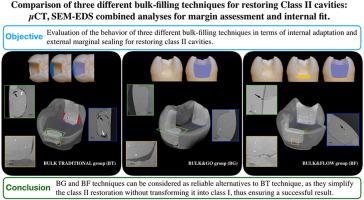Journal of the Mechanical Behavior of Biomedical Materials ( IF 3.3 ) Pub Date : 2021-09-03 , DOI: 10.1016/j.jmbbm.2021.104812 Angelo Putignano 1 , Vincenzo Tosco 1 , Riccardo Monterubbianesi 1 , Flavia Vitiello 1 , Maria Laura Gatto 2 , Michele Furlani 1 , Alessandra Giuliani 1 , Giovanna Orsini 1

|
Objective
Evaluation of the behavior of three different bulk-filling techniques in terms of internal adaptation and external marginal sealing for restoring class II cavities.
Methods
Fifteen extracted sound molar teeth were used. Two standardized class II mesio/disto-occlusal (MO/DO) slot cavities, 4 mm long, 4 mm wide and 3 mm deep were prepared in each tooth, obtaining n=30 cavity preparations. The cavities were randomly assigned into three groups (n=10 per group) according to three bulk filling techniques: Bulk Traditional (BT), Bulk&Go (BG) and Bulk&Flow (BF). The teeth were analyzed by scanning electron microscopy (SEM) to investigate the external marginal seal. Thereafter, the chemical composition of tooth-restoration interface was analyzed by energy-dispersive X-ray spectroscopy (EDS). Complementary information to the SEM and EDS were obtained by micro-computed tomography (μCT) to assess the internal fit.
Results
SEM analysis showed a proper external marginal seal for all groups tested as confirmed by the EDS investigation, highlighting the presence of adhesive layer at the tooth-restoration interface. The internal marginal adaptation by means of μCT analysis revealed gaps formation at the tooth–restoration interface only for BT group, while an intimate contact free of gaps were found in the other two groups. Moreover, in BT and BF groups voids were present within the restoration.
Significance
BG and BF techniques can be considered as reliable alternatives to BT technique, as they simplify the class II restoration without transforming it into class I, thus ensuring a successful result.
中文翻译:

用于修复 II 类蛀牙的三种不同批量填充技术的比较:μCT、SEM-EDS 边缘和内部配合评估的组合分析
客观的
评估三种不同的散装填充技术在修复 II 类空腔的内部适应和外部边缘密封方面的行为。
方法
使用了十五颗拔除的完好臼齿。在每颗牙齿中制备两个标准化的II类近中/远侧咬合(MO/DO)槽洞,长4毫米,宽4毫米,深3毫米,获得n=30个洞预备体。根据三种散装填充技术,将空腔随机分为三组(每组 n = 10):散装传统(BT)、散装&Go(BG)和散装&流动(BF)。通过扫描电子显微镜(SEM)对牙齿进行分析,以研究外部边缘密封。此后,通过能量色散X射线光谱(EDS)分析牙齿修复界面的化学成分。通过微型计算机断层扫描 (μCT) 获得 SEM 和 EDS 的补充信息,以评估内部配合。
结果
SEM 分析显示,经 EDS 调查证实,所有测试组均具有适当的外部边缘密封,突出显示牙齿修复体界面处存在粘合层。通过μCT分析的内部边缘适应显示,仅BT组的牙齿-修复体界面处形成间隙,而其他两组则发现无间隙的紧密接触。此外,在 BT 和 BF 组中,修复体内存在空隙。
意义
BG 和 BF 技术可以被认为是 BT 技术的可靠替代方案,因为它们简化了 II 类修复而不将其转换为 I 类,从而确保了成功的结果。









































 京公网安备 11010802027423号
京公网安备 11010802027423号